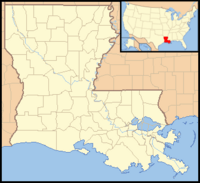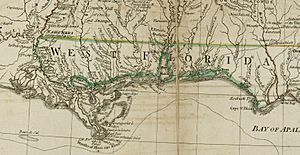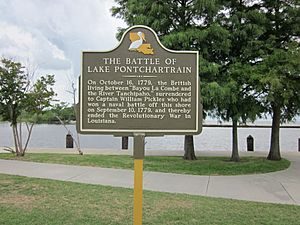Battle of Lake Pontchartrain facts for kids
Quick facts for kids Battle of Lake Pontchartrain |
|||||||
|---|---|---|---|---|---|---|---|
| Part of the Gulf Coast campaign | |||||||
 Map showing modern Louisiana. Lake Pontchartrain is the large lake in its easternmost area, and is just north of New Orleans |
|||||||
|
|||||||
| Belligerents | |||||||
| Commanders and leaders | |||||||
| William Pickles | John Willett Payne (WIA) | ||||||
| Strength | |||||||
| 57 men 1 schooner (USS Morris) |
15 men 1 sloop (HMS West Florida) |
||||||
| Casualties and losses | |||||||
| 6–8 killed some wounded |
2 killed 1 wounded 1 sloop captured |
||||||
The Battle of Lake Pontchartrain was a naval fight between two ships. It happened on September 10, 1779. This battle was part of the Anglo-Spanish War. It took place on Lake Pontchartrain, which was then part of British West Florida. Today, this area is in Louisiana.
The battle was between the British ship HMS West Florida and the American ship USS Morris. The West Florida was a sloop-of-war, a type of small warship. The Morris was a schooner, a fast sailing ship. The American ship, led by Captain William Pickles, had a larger crew. They successfully boarded the British ship. The British captain, Lieutenant John Payne, was badly wounded. Capturing the West Florida removed the main British naval presence on the lake. This made British control over western West Florida much weaker.
Contents
Why This Battle Happened
The War Comes to the Gulf Coast
The American Revolutionary War mostly happened on the East Coast of America. But in 1779, Spain joined the war. This brought fighting to the Gulf Coast. Before 1779, New Orleans was the capital of Spanish Louisiana. It secretly helped the American side.
Oliver Pollock was a businessman in New Orleans. He acted as an agent for the American government. He worked with Spanish governors. He also spent his own money to help the American cause. This support was for American activities along the lower Mississippi River.
The Ships Involved
In 1778, an American named James Willing led a raid. He attacked British targets in West Florida. He captured a British ship called Rebecca. This ship was then added to the American navy. It was renamed USS Morris. It was named after Robert Morris, a rich man from Philadelphia.
The British province of West Florida stretched from the Mississippi River to the Apalachicola River. The British ship HMS West Florida had been sailing on Lake Pontchartrain since 1776. It would stop and search ships, even Spanish merchant ships. This annoyed the Spanish. In early 1779, Lieutenant John Payne took command of the West Florida. He knew the area well. The West Florida was a sloop-of-war. It had several cannons. It usually had about 30 crew members.
Leading Up to the Fight

Lieutenant Payne sailed the West Florida without trouble until August 1779. On August 27, he sent a small boat with men to Manchac. They were supposed to meet British soldiers there. But the boat never came back.
On that same day, Bernardo de Gálvez started an attack. He was the governor of Spanish Louisiana. He wanted to take control of British military posts on the Mississippi River. Gálvez's men captured Payne's boat. Gálvez successfully took the Manchac fort on September 7. He later forced the British to surrender after the Battle of Baton Rouge. But Payne did not know about these events.
Oliver Pollock gave Captain William Pickles command of the Morris. However, the original Morris was destroyed in a hurricane. So, Governor Gálvez gave Pickles another ship. This ship was a schooner. It had five small cannons and ten swivel guns. Swivel guns are small cannons that can turn easily. The ship did not have strong walls to protect the crew. Also, the crew was not ready for close fighting. They did not have axes or spears. Pollock told Pickles to attack British military ships on the lake.
The Battle Begins
Pickles sailed from New Orleans with 57 American and Spanish crew members. To hide his plans, Pickles flew a British flag. This is called a false flag. On September 10, the two ships saw each other. Payne, the British captain, called out to the Morris. He wanted to know what their plans were. Pickles said they were a merchant ship going to Pensacola.
Then, Pickles quickly took down the British flag. He raised an American flag instead. The Americans and Spaniards then threw grappling hooks. These hooks pulled the two ships close together. They started firing their swivel guns. Lieutenant Rousseau, Pickles' second-in-command, got a boarding party ready. It is likely that neither ship fired its larger cannons.

Payne's small crew fought bravely. They pushed back the American boarders two times. But the third time, the Americans succeeded. Captain Payne was badly wounded during the "very violent" fighting. The Americans took over the British ship. Two British men were wounded, besides Payne. The Americans lost six to eight men and had several wounded.
What Happened Next
Captain Pickles took the captured ship back to New Orleans. Oliver Pollock then prepared the ship for use. Pickles sailed the ship in West Florida's waters. He did this while Governor Gálvez marched up the Mississippi River. Pickles then helped Gálvez in the Battle of Fort Charlotte. This battle led to the capture of Mobile. After that, Pickles sailed the ship to Philadelphia to sell it.
A historic marker in Mandeville, Louisiana, remembers this battle. The marker says that William Pickles helped end the Revolutionary War in Louisiana. Some British people on the north shore of Lake Pontchartrain surrendered to Captain Pickles. This happened in mid-October 1779. This was three weeks after the Battle of Baton Rouge. In this case, "Louisiana" means the future state of Louisiana. It does not mean the larger area of Spanish Louisiana. The Battle of St. Louis also happened in Spanish Louisiana in 1780.
See also
 In Spanish: Batalla del Lago Pontchartrain para niños
In Spanish: Batalla del Lago Pontchartrain para niños

